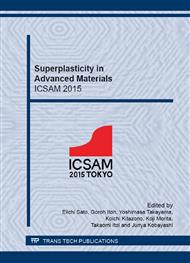[1]
T.G. Nieh, J. Wadswort, O.D. Sherby, Superplasticity in Metals and Ceramics, Cambridge University Press, United Kingdom, (1997).
Google Scholar
[2]
M. Omori, Sintering, Consolidation, Reaction and crystal growth by the spark plasma system (SPS), Mater. Sci. Eng. A 287 (2000) 183-88.
DOI: 10.1016/s0921-5093(00)00773-5
Google Scholar
[3]
D.M. Hulbert, D. Jiang, J.D. Kuntz, Y. Kodera, A.K. Mukherjee, A low-temperature high-strain-rate formable nanocrystalline superplastic ceramic, Scripta Mater. 56 (2007) 1103–06.
DOI: 10.1016/j.scriptamat.2007.02.003
Google Scholar
[4]
K. Morita, K. Hiraga, B. -N. Kim, H. Yoshida, Y. Sakka, Synthesis of dense nanocrystalline ZrO2–MgAl2O4 spinel composite, Scripta Mater. 53 (2005) 1007-12.
DOI: 10.1016/j.scriptamat.2005.07.008
Google Scholar
[5]
K. Morita, K. Hiraga, B. -N. Kim, H. Yoshida, Y. Sakka, to be submitted.
Google Scholar
[6]
K. Morita, K. Hiraga, B. -N. Kim, H. Yoshida, Superplasticity of nanocrystalline ZrO2-spinel composite, Key Eng. Mater. 345-346 (2007) 573-76.
DOI: 10.4028/www.scientific.net/kem.345-346.573
Google Scholar
[7]
W. -J. Kim, J. Wadsworth, O.D. Sherby, Tensile ductility of superplastic ceramics and metallic alloy, Acta Mater. 39 (1991) 199-208.
DOI: 10.1016/0956-7151(91)90268-6
Google Scholar
[8]
K. Hiraga, K. Nakano, T.S. Suzuki, Y. Sakka, Processing-dependent microstructural factors affecting cavitation damage and tensile ductility in a superplastic alumina dispersed with zirconia, J. Am. Ceram. Soc. 85 (2002) 2763-70.
DOI: 10.1111/j.1151-2916.2002.tb00526.x
Google Scholar
[9]
K. Morita, B. -N. Kim, K. Hiraga, H. Yoshida, Fabrication of transparent MgAl2O4 spinel polycrystal by spark plasma sintering processing, Scripta Mater. 58 (2008) 1114-17.
DOI: 10.1016/j.scriptamat.2008.02.008
Google Scholar
[10]
K. Morita, B. -N. Kim, K. Hiraga, H. Yoshida, Spark-plasma-sintering condition optimization for producing transparent MgAl2O4 spinel polycrystal, J. Am. Ceram. Soc. 92 (2009) 1208-16.
DOI: 10.1111/j.1551-2916.2009.03074.x
Google Scholar
[11]
K. Morita, B. -N. Kim, H. Yoshida, H. Zhang, K. Hiraga, Y. Sakka, Effect of loading schedule on densification of MgAl2O4 spinel during spark plasma sintering (SPS) processing, J Eur. Ceram. Soc. 32 (2012) 2303-09.
DOI: 10.1016/j.jeurceramsoc.2012.02.016
Google Scholar
[12]
R. Apetz, M.P.B. van Bruggen, Transparent alumina: A light scattering model, J. Am. Ceram. Soc. 86 (2003) 480-86.
DOI: 10.1111/j.1151-2916.2003.tb03325.x
Google Scholar
[13]
G.R. Villalobos, J.S. Sanghera, I.D. Aggarwal, Degradation of magnesium aluminum spinel by lithium fluoride sintering aid, J. Am. Ceram. Soc. 88 (2005) 1321-22.
DOI: 10.1111/j.1551-2916.2005.00209.x
Google Scholar
[14]
R.J. Bratton, Translucent sintered MgAl2O4, J. Am. Ceram. Soc. 57 (1974) 283-86.
Google Scholar
[15]
K. Hamano, S. Kanzaki, Fabrication of transparent spinel ceramics by reactive hot-pressing, J. Ceram. Soc. Japan 85 (1977) 225-30.
DOI: 10.2109/jcersj1950.85.981_225
Google Scholar
[16]
N. Frage, S. Cohen, S. Meir, S. Kalabukhov, M.P. Dariel, Spark plasma sintering (SPS) of transparent magnesium-aluminate spinel, J. Mater. Sci. 42 (2007) 3273-76.
DOI: 10.1007/s10853-007-1672-0
Google Scholar
[17]
R. Chaim, Z. Shen, M. Nygren, Transparent nanocrystalline MgO by rapid and low- temperature spark plasma sintering, J. Mater. Res. 19 (2004) 2527-31.
DOI: 10.1557/jmr.2004.0334
Google Scholar
[18]
S. Grasso, C. Hu, G. Maizza, B. -N. Kim, Y. Sakka, Effects of pressure application method on transparency of spark plasma sintered alumina, J. Am. Ceram. Soc. 94 (2010) 1405-09.
DOI: 10.1111/j.1551-2916.2010.04274.x
Google Scholar
[19]
C. Wang, Z. Zhao, Transparent MgAl2O4 ceramic produced by spark plasma sintering, Scripta Mater. 61 (2009) 193-96.
DOI: 10.1016/j.scriptamat.2009.03.039
Google Scholar
[20]
L. -Q. An, A. Ito, T. Goto, Transparent yttria produced by spark plasma sintering at moderate temperature and pressure profiles, J. Eur. Ceram. Soc. 32 (2012) 1035-40.
DOI: 10.1016/j.jeurceramsoc.2012.03.011
Google Scholar
[21]
K. Morita, B. -N. Kim, H. Yoshida, K. Hiraga, Y. Sakka, to be submitted.
Google Scholar


